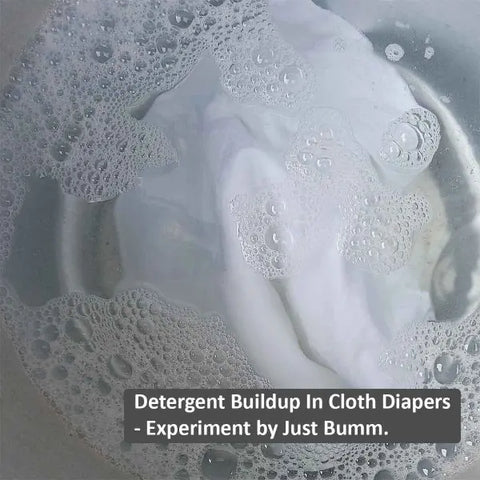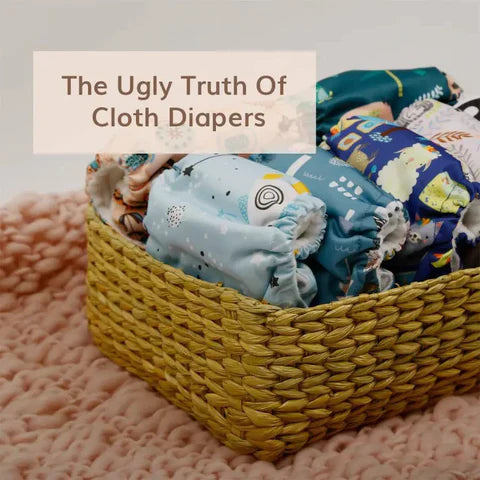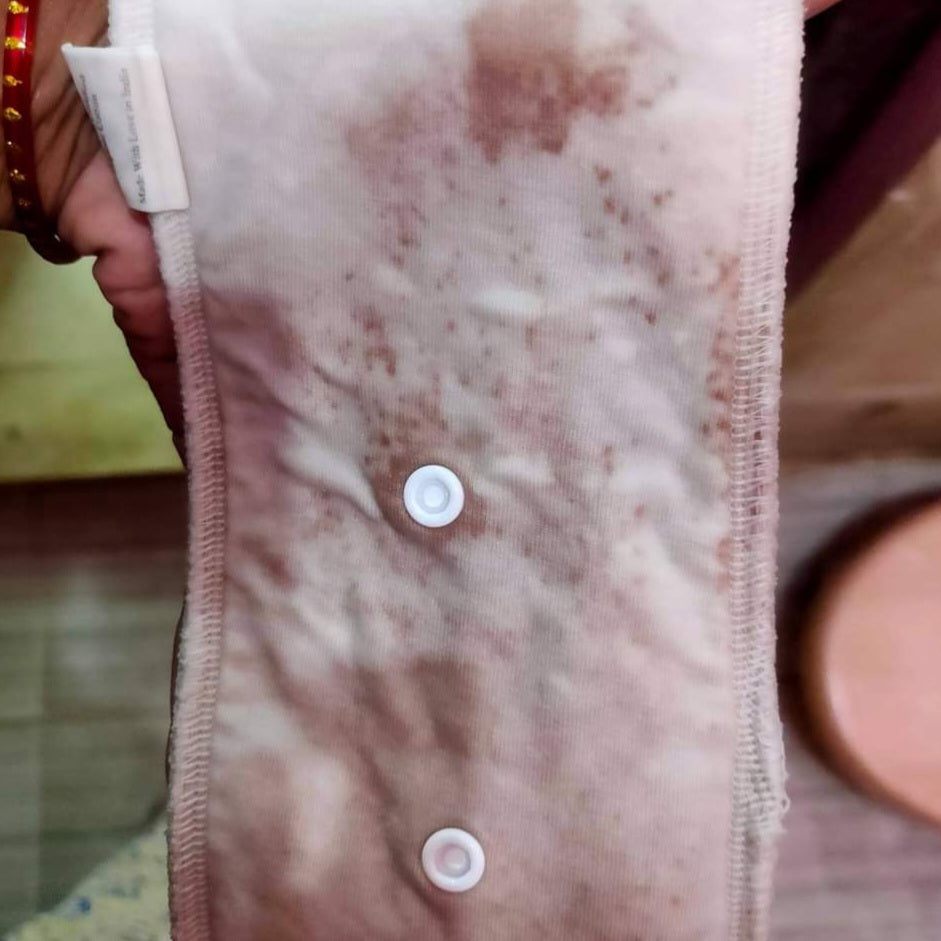Buildup in Cloth Diapers indicates concentration leftover due to poor wash routine, hard water minerals, and overuse of detergent, and products. You should not take buildup issues lightly as it causes rashes, ammonia burn, and infection. So as important as this issue is, you need to understand the causes and remedies that we suggest for it. Before we get to the good part, always remember to have a good wash routine for your baby’s cloth diapers. A Good Wash Routine will help you stay away from buildup issues. Read How to Wash Cloth Diapers here.

What are the types of buildup in cloth diapers?
Let’s take a small glimpse of the types before we discuss detergent buildup. There are four types of Buildup in cloth diapers. Yes, you might have heard about some but not all. Although some causes might be simple, some are beyond control. But you can always prevent it from occurring by taking the right measures. The Common types of Buildups in Cloth diapers are as follows.
- Detergent Buildup – The Quickest to occur.
- Ammonia Buildup – The Most Troublesome one.
- Mineral Buildup – The ‘Not your fault’ one.
- Product Buildup – The ‘You forgot to do something!’ one.
What is Detergent Buildup?
The detergent buildup is the concentration of leftover detergent that is not rinsed off well from your baby’s diapers. The Excess detergent from the deepest layers of the diaper will bind and form buildup when your baby poops or pees. This will cause leaks in diapers and rashes in babies if you leave the buildup issue untreated for a very long time. Click the below list to jump sections.
- Why is detergent buildup caused?
- How to prevent detergent buildup in cloth diapers?
- What to do with the affected cloth diapers?
- How to remove detergent buildup from cloth diapers?
Why is detergent buildup caused?
Detergent buildup will occur if you use more detergent than recommended. Is that all? No. If you hand wash the diapers, you are more likely not rinsing the cloth diapers well or agitating enough. Using the wrong detergent for your top or front load machines will cause detergent buildup. Also if you choose the wrong mode in your washing machine, you will end up with detergent buildup. Not cleaning the washer will also cause detergent buildup. Sounds like pretty much everything will cause detergent buildup, right?
More Detergent, Less Agitation
Using more detergent than the recommended amount will cause more suds. “More suds means the clothes will not rub against each other in the washer or the bucket. Which will prevent the dirt and detergent from washing out” – Ariel.
You need agitation in water so that the water will enter the deepest layers and bring back the detergent particles along with the dirt to the surface. The dirt and detergent will bind together and stay there if you do not agitate well. So after drying, it slowly starts to become harder and the pads won’t absorb properly.
Sometimes, if you have soft water, which is softer than usual adding the original recommended amount can be a problem. Because Soft water produces more lather by itself. So If you add detergent to it, it will produce more foam. It’s safe to always test the water for hardness or softness.

Wrong Detergent & Wrong Mode
Detergents are made according to every type of washing machine. “A Front-load detergent will produce less sud than a top-load detergent” – Ariel. As in front load machines, the spin and agitation are higher, the foam dispersal is also quite high. So the top load detergent won’t work well if you use it for the front load causing buildup.
Cloth Diapers are heavily soiled laundry. So you need to choose the right mode to remove the dirt well. Therefore if you choose the gentle or baby mode, the machine will work accordingly and so there will be less agitation and spin. The Spin and RPM vary for each mode and so is the rinsing time. “Fully Automatic Machines will adjust the spin and rinse cycle according to the load size and the mode you choose” – Whirlpool. This will neither remove the pee nor the detergent. You will end up with both ammonia and detergent buildup.
How Much Detergent to use for Cloth Diapers?

How to prevent detergent buildup in cloth diapers?
To prevent detergent buildup, keep these things in mind.
- Always choose a powerful cleaning agent.
- Choose the right type of detergent for your machine.
- Don’t forget to rinse the diapers well if you hand wash your cloth diapers.
- You need more agitation and spin.
- Use only the recommended amount of detergent.
- Clean your washer regularly.
- Choose the right washing mode for cloth diapers.
What to do with affected Cloth diapers?
As quick as it is to catch up, you can reset the affected diapers just as quickly. You also need to test the diapers for detergent buildup to confirm that it is what you are dealing with. There are signs like repelling, high detergent smell, and leaks, but it is common for other buildup types too. So do the detergent buildup test.
How to do the detergent buildup test? You need a mug or bowl of plain water to fit in a pad that is affected. For testing, take a pad that you think is affected and soak it in the bowl. Once soaked, squeeze it inside the water with your hands. Keep squeezing repeatedly so that the water goes in and out. If you feel the water is turning soapy or you can see visible soap suds, Voila! You have detergent buildup. Watch Video Tutorial Here.
Detergent Buildup Test showing soap scum in Cloth Diapers

How do I remove detergent buildup?
Detergent Buildup is easy to remove. You don’t have to strip the diapers. You only need to rinse the diapers in plain water till there are no soap suds at all. Although the method is simple, you need to keep rinsing them and it’s quite an energy-consuming process. We have two methods to remove detergent buildup from cloth diapers. You can rinse and agitate by hand wash or you can run a Spin and Rinse Cycle in Washing Machine. Do not add detergent in any of the methods as you are removing the buildup. You should keep rinsing in plain water till all soap suds are gone and the water appears clear as in the image below.
Clean Cloth Diaper Pad after removing detergent buildup

Tip: I would also suggest that you use warm to hot water because hot water can remove the detergent residue from the layers. However hot water rinse sometimes may not be effective for all types of buildup. You will observe more smell and stink if the residue is not removed properly.
As quick as it is to catch up, you can reset the affected diapers just as quickly. You also need to test the diapers for detergent buildup to confirm that it is what you are dealing with. There are signs like repelling, high detergent smell, and leaks, but it is common for other buildup types too. So do the detergent buildup test.
How to do the detergent buildup test? You need a mug or bowl of plain water to fit in a pad that is affected. For testing, take a pad that you think is affected and soak it in the bowl. Once soaked, squeeze it inside the water with your hands. Keep squeezing repeatedly so that the water goes in and out. If you feel the water is turning soapy or you can see visible soap suds, Voila! You have detergent buildup. Watch Video Tutorial Here.
Detergent Buildup Test showing soap scum in Cloth Diapers

How do I remove detergent buildup?
Detergent Buildup is easy to remove. You don’t have to strip the diapers. You only need to rinse the diapers in plain water till there are no soap suds at all. Although the method is simple, you need to keep rinsing them and it’s quite an energy consuming process. We have two methods to remove detergent buildup from cloth diapers. You can rinse and agitate by hand wash or you can run a Spin and Rinse Cycle in Washing Machine. Do not add detergent in any of the methods as you are removing the buildup. You should keep rinsing in plain water till all soap suds are gone and the water appears clear as in the image below.
Clean Cloth Diaper Pad after removing detergent buildup




Leave a comment
All comments are moderated before being published.
This site is protected by hCaptcha and the hCaptcha Privacy Policy and Terms of Service apply.